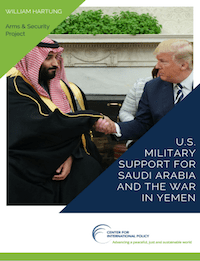Bill Hartung, a colleague from our project, Indefensible: Seven Myths that Sustain the Global Arms Trade, has just authored an important new report, U.S. Military Support for Saudi Arabia and the War in Yemen (Center for International Policy, November 2018). Below is an excerpt of he Summary and Key Findings, we recommend reading the report in its entirety, which is available through the Center for International Policy.
Summary
The Saudi regime’s murder of Jamal Khashoggi and its continued killing of civilians in Yemen has drawn unprecedented scrutiny to the U.S.-Saudi military relationship. This report looks at that relationship in closer detail, with an eye towards how it creates leverage that the U.S. can use to change Saudi conduct and end the Yemen war.
The assassination of U.S. resident and Washington Post contributor Jamal Khashoggi, a Saudi national, at the hands of the Saudi regime has provoked a rethinking of U.S.-Saudi relations in general, and military relations in particular.1 President Trump’s declaration that he would not stop U.S. arms sales to the kingdom even if it is responsible for Khashoggi’s death frighteningly suggests that contractor profits and a small number of jobs take precedence over the need to hold a murderous regime accountable.2
The President’s assertion that it is possible to balance benefits to the U.S. economy against the heinous behavior of an ally doesn’t hold up to scrutiny. No economic benefit, no matter how large, can justify continuing to arm a regime that has not only killed a journalist in the most brutal way imaginable but has killed thousands of civilians in indiscriminate bombing attacks in Yemen, many of them with U.S.-supplied bombs and aircraft.3
But if economic arguments are to be brought into play, they should at least be accurate. This has not been the case. The president has claimed a sweeping range of jobs flowing from his alleged $110 billion arms deal with Riyadh, from 40,000 to “over a million,” in one case boosting his estimate by 400,000 jobs within just a few days’ time. To be fair, it seems like the million jobs figure was meant to include some commercial deals as well as the purported arms sales, but the president’s ad hoc utterances on the subject make it hard to know for sure.4
The biggest flaw in President Trump’s ever-growing estimate of the U.S. jobs at stake in arms sales to Saudi Arabia is that the size of the alleged $110 billion U.S.-Saudi arms deal – in some cases referred to as if it is a single transaction — is wildly exaggerated. The White House has issued a list of deals adding up to $110 billion, but most of them were either notified to Congress during the Obama administration, or are projections far into the future of potential sales that are unlikely to ever occur.5 In hard numbers, the State Department estimates that the Saudi regime has signed $14.5 billion in letters of offer and acceptance (LOA’s) for new weaponry and support equipment since President Trump took office.6 That’s a little over 10% of the much touted $110 billion figure. And these letters of offer and acceptance represent only one step in a longer process, not signed contracts.7
Another way of looking at the issue is that Congress has received $20 billion in notifications of potential new arms sales to Saudi Arabia since President Trump took office. There have also been roughly $2 billion in deals licensed by the State Department, for a total of $22 billion.8 Most of these have not reached the stage of a letter of offer and acceptance being signed, and the largest one, a $13.5 billion deal for a Lockheed Martin Theater High Altitude Area Defense (THAAD) missile defense system, is still under discussion.9 A September 30, 2018 deadline for Saudi Arabia to take advantage of a 20% discount on the deal is long past.
All of the major Saudi arms sales in the pipeline are based on arrangements made during the Obama years, when that administration notified Congress of a record $117 billion in arms offers to Saudi Arabia over its eight years in office.10 Over those same eight years, there were $65 billion worth of formal agreements signed with Saudi Arabia and roughly $18 billion in deliveries made.11 The discrepancy between offers, agreements and deliveries is a result of the fact that a significant number of offers don’t eventuate in agreements or sales. In addition, deliveries generated by completed deals are often spread out over many years. And finally, the value of some deals is reduced between the time of the initial offer and the final agreement.
Key Findings
- The Saudi military is heavily dependent on U.S. weapons and support, and could not op- erate effectively without them. Two-thirds of the 365 combat capable aircraft in the Saudi arsenal are of U.S.-origin, including 171 F-15 combat aircraft, a mainstay of the Saudi air war in Yemen. The Saudi land forces and national guard possess over 3,000 U.S.-supplied armored vehicles, and the Saudis have tens of thousands of U.S.-supplied bombs and missiles.
- The Trump administration has not concluded a “$110 billion arms deal” with Saudi Arabia. President Trump’s much touted mega-deal with Saudi Arabia is a mixture of orders approved during the Obama administration, a few new offers, and tens of billions in speculative deals. Actual deals implemented since President Trump took office total just $14.5 billion.
- Saudi arms sales support at most tens of thousands of jobs in the United States, not hun- dreds of thousands or “a million,” as President Trump has claimed. Actual, paid-for de- liveries of U.S.-produced arms for Saudi Arabia have averaged about $2.5 billion per year over the past decade, enough to support at most 20,000 to 40,000 jobs, some of which are located overseas (see below). In addition, a significant number of the jobs sustained or created by Saudi arms deals would not be at risk if specific deals were cancelled. Many of the workers now involved in producing arms for Saudi Arabia would be shifted to other projects by firms that have record backlogs for existing contracts with the Pentagon. And an analysis by Reuters has revealed that most U.S. defense contractors expect “relatively minor additions to their U.S. workforce and [a] more significant buildup in Saudi Arabia” as a result of arms deals now in the works.12
- Many of the jobs created by U.S. arms sales to Saudi Arabia will be located in Saudi Arabia. The jobs impact of Saudi arms sales in the United States will be further reduced by the fact that the new Saudi economic plan aims to have 50% of the value of that nation’s arms sales produced in the kingdom itself. U.S. firms like Raytheon, Lockheed Martin, and Boeing have pledged allegiance to this goal. Raytheon CEO Thomas Kennedy summed up this approach: “By working together, we can help build world-class defense and cyber capabilities in the Kingdom of Saudi Arabia.”
- The U.S.-Saudi arms trade has a marginal impact on the U.S. economy. Even the high-end estimate of 40,000 U.S. jobs related to Saudi arms deals represents less than three one-hundredths of one percent of the U.S. labor force of over 160 million people.
- Boeing, Raytheon, Lockheed Martin and General Dynamics are by far the biggest beneficiaries of the U.S.-Saudi arms trade: From combat aircraft and attack helicopters (Boeing), to precision-guided bombs (Raytheon and Lockheed Martin), to missile defense systems (Raytheon and Lockheed Martin), to combat ships (Lockheed Martin) to tanks (General Dynamics), to transport planes and helicopters (Lockheed Martin), the largest U.S. defense contractors are the biggest customers and most important suppliers of the Saudi military.
- Cutting off U.S. arms and support is the best way to press for an end to the Yemen war. A bi-partisan set of members of Congress from both houses are pressing for an end to arms sales and military support for the Saudi/UAE intervention in Yemen, and the time is ripe to move forward on these efforts, even as the administration has pledged to seek a ceasefire there and to end U.S. refueling of Saudi aircraft.
- The sections that follow provide the key details necessary to understand the scale and nature of the U.S. military relationship with Saudi Arabia, from the arms and weapons systems involved to the use of such equipment in the Saudi-led war in Yemen. It also examines the question of who benefits most from this relationship, and concludes with a section on the growing Congressional opposition to the status quo.
Featured photo courtesy of MANDEL NGAN/AFP / Getty Images.



